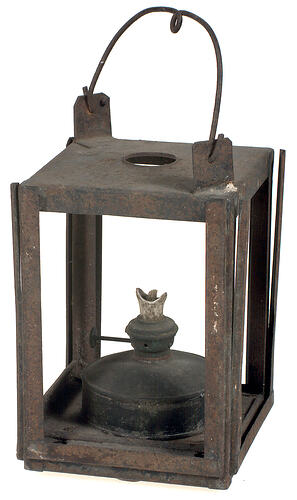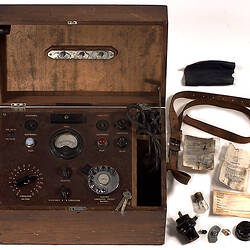Summary
Oil lamp, circa 1880. Used at the Kew Asylum, circa 1872 - 1900, a psychiatric hospital in Victoria Australia. Could be hand-made.
Provision for the establishment of Kew Asylum was made in the colony of Victoria's first piece of lunacy legislation, the Lunacy Statute 1867. Sister institutions were also provided for at Beechworth and Ararat to accommodate lunatics in regional communities. Kew opened its doors to receive its first patients in 1871 as a ward of the existing Yarra Bend Asylum, and was proclaimed as an indepdendent institution in 1872. The provision at the public expense of asylums for the reception of the colony's lunatics represented a significant shift in attitudes towards the mentally ill away from earlier custodial management techniques where lunatics, regarded as merely a sub-category of the broader deviant population, were thrown in the Collins Street gaol with criminals, paupers and other vagrants, towards a more humane and enlightened approach where treatment, if not even a full recovery of theor reason, might be possible within the walls of the grand curative asylum.
Physical Description
Lamp consists of an open-sided hollow box with a round oil holder set in the base. The oil container is surmounted by a short chimney with a tooth-shaped porcelain wick-feeder inserted into the top. The wick protrudes out of this. The handle for regulating the wick is inserted into the metal part of the chimney. The bottom of the lantern has a round insulation hole beneath the oil container in the centre and 4 large studs for standing. The columns that constitute the sides of the box have an attached frame to hold glass windows. The roof of the box has a ventilation hole in the centre and brackets to support a semi-circular wire handle with a curl (for stable hanging) in the centre.
Significance
Example of lighting used in psychiatric hospitals in Victoria, Australia.
More Information
-
Collection Names
-
Collecting Areas
-
Acquisition Information
Donation from Kew Mental Hospital (Asylum), Office of Psychiatric Services, May 1985
-
Place & Date Used
Kew Mental Hospital (Asylum), Kew, Greater Melbourne, Victoria, Australia, 1872-1900
-
Classification
Medicine & health, Mental health - institutional life, Illumination
-
Category
-
Discipline
-
Type of item
-
overall dimensions
14.5 cm (Length), 14.5 cm (Width), 29 cm (Height)
-
Dimensions
145 mm (Length), 145 mm (Width), 290 mm (Height)
Measurement From Conservation. Measuring Method: max dimensions
-
Keywords
Hospitals, Lighting, Psychiatric Hospitals, Making History - Psych Services, Psychiatric Institutions, Psychiatric Services, Mental Health, Mental Health Institutions

